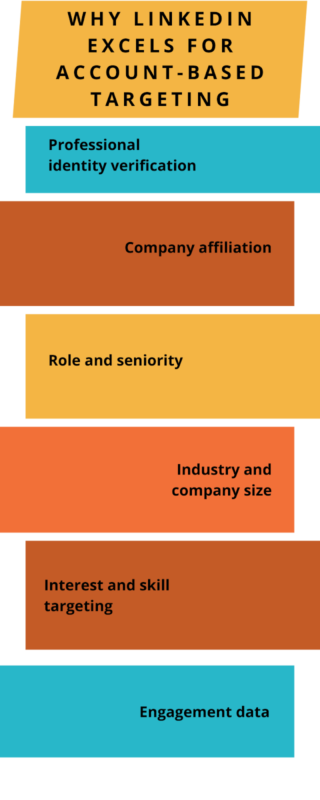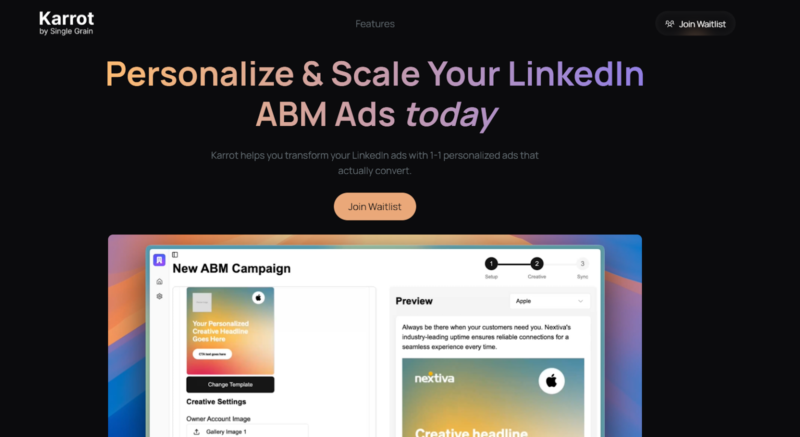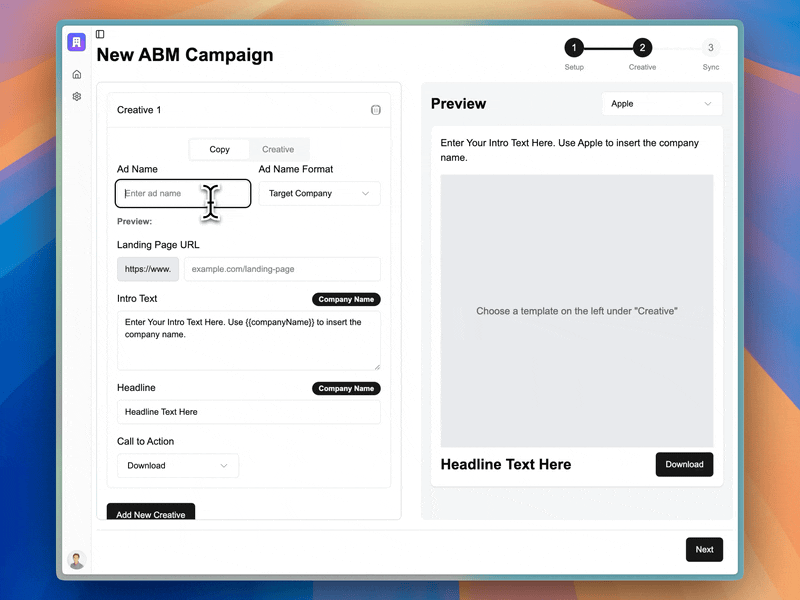When implementing account-based marketing (ABM), you may hear the same advice, such as aligning your sales and marketing teams and creating hyper-personalized content. But without knowing your target accounts, your efforts will be wasted.
How do you identify your target accounts and segments? Fortunately, LinkedIn makes this easy. LinkedIn has emerged as the premier platform for account-based marketing (ABM), offering unparalleled targeting capabilities that allow marketers to connect with specific companies and roles with remarkable precision.
Understanding effective account-based targeting is still best to build your ABM lists and pinpoint key decision-makers. Here are the best ABM targeting tools and techniques for LinkedIn.
Key Highlights
- LinkedIn’s professional data makes it the most effective platform for B2B account-based targeting.
- 70% of marketers now have active ABM programs, but many fail to fully utilize LinkedIn’s targeting capabilities.
- Organizations with a strong ICP achieve 68% higher account win rates than those with poorly defined targeting.
- LinkedIn’s matched audiences feature allows for precise targeting of specific accounts and decision-makers.
- Layered targeting approaches combining company, role, and behavioral data deliver the highest performance.
- AI-powered tools like Karrot.ai can enhance targeting precision through predictive analytics.
- Retargeting strategies that capture engaged prospects increase conversion rates by up to 40%.
- Regular targeting refinement based on performance data can improve campaign ROI by 25-30%.
TABLE OF CONTENTS:
LinkedIn Targeting for ABM
At the heart of effective ABM is precise targeting—identifying and reaching specific accounts and decision-makers with personalized messaging.
LinkedIn is the premier platform for ABM targeting due to its professional focus and rich data collection. There are over 13 million company pages on LinkedIn, so that you can target numerous companies in your industry.
In addition, there are over 1 billion LinkedIn members across 200 countries and counting. As a result, LinkedIn provides unparalleled access to businesses and key decision-makers.
Why LinkedIn Excels for Account-Based Targeting

LinkedIn’s targeting capabilities are uniquely suited for ABM for several reasons:
- Professional identity verification: Users maintain accurate professional profiles.
- Company affiliation: Clear connections between individuals and organizations.
- Role and seniority: Ability to target by job function and level.
- Industry and company size: Precise targeting by firmographic attributes.
- Interest and skill targeting: Reach people based on professional interests.
- Engagement data: Target based on content and ad interactions.
With LinkedIn, businesses can build an extensive list of companies for targeting. Brands can use this data to tailor their ABM LinkedIn advertising campaign to target these accounts. All of this is the foundation of successful ABM.
Step 1: Define Your Target Account Parameters
The foundation of effective LinkedIn targeting is a clearly defined ideal customer profile (ICP), which you will use to make your target account list. Organizations with a strong ICP achieve 68% higher account win rates than those with poorly defined targeting.
Creating Your Ideal Customer Profile
The first step in creating your ICP is identifying core attributes. Your ICP should include both firmographic and technographic data. Here are a few attributes to start with:
| Parameter Type | Examples | LinkedIn Targeting Option |
|---|---|---|
| Industry | Technology, Financial Services, Healthcare | Industry targeting |
| Company Size | 1,000-5,000 employees, $100M+ revenue | Company size targeting |
| Geography | North America, EMEA, APAC | Location targeting |
| Technology Stack | CRM systems, Marketing Automation | Skills and groups targeting |
| Growth Stage | Series B funding, Expanding to new markets | Company growth rate targeting |
| Business Model | SaaS, Professional Services, Manufacturing | Industry and groups targeting |
This detailed ICP becomes the foundation for your LinkedIn targeting strategy, ensuring your campaigns reach companies that match your ideal customer characteristics.
Identifying your ideal customer may require market research and data collection depending on your niche. Creating accurate ICPs is essential since you’ll use this data to create customer personas that identify their pain points and goals.
Building Your Target Account List
With your ICP defined, build your target account list through:
- CRM analysis: Identify existing customers that match your ICP.
- Intent data: Find companies showing interest in your solution category.
- Tools: Using software like Karrot.ai to identify companies using complementary technologies.
- LinkedIn Sales Navigator: Search for companies matching your ICP criteria.
- Industry reports: Target companies featured in relevant industry analyses.
From here, ABM marketers can implement lead scoring and segment accounts based on shared characteristics. This focused approach allows for more personalized engagement with each account.
Step 2: Master LinkedIn’s Core Targeting Options
LinkedIn offers several targeting approaches that can be combined for precise account-based targeting. These include company and role-based targeting, and even more.
Company Targeting
Company targeting is when ABM marketers build audiences and segments by businesses and organizations. Target specific organizations through:
- Company name targeting: Reach employees at named organizations.
- Company industry: Target companies in particular sectors.
- Company size: Focus on organizations by employee count.
- Company growth rate: Target based on employee growth patterns.
- Company category: Target by categories like Fortune 500.
Role-Based Targeting
You can narrow your list to reach specific decision-makers within target companies. This is helpful to boost engagement rates among individual roles. Here are examples of roles you can target:
- Job title: Target specific titles (e.g., “Chief Marketing Officer”).
- Job function: Reach broader role categories (e.g., “Marketing”).
- Seniority level: Target by level (e.g., “Director” and above).
- Skills: Target based on self-reported professional skills.
- Groups: Reach members of professional LinkedIn groups.
Matched Audiences
LinkedIn’s Matched Audiences feature retargets leads who previously visited your website. This is helpful for ABM targeting and can further build your account list. Here are ways that you can use the Matched Audiences feature:
- Account targeting: Upload a list of target companies.
- Contact targeting: Upload specific contact emails.
- Website retargeting: Target users who have visited your website.
- Engagement retargeting: Reach users who have engaged with your content.
Recent data shows that campaigns using Matched Audiences see a 30% increase in CTR and a 14% decrease in cost-per-conversion compared to standard targeting approaches.
Step 3: Implement Advanced Targeting Strategies
Beyond the basic targeting options, several advanced strategies can enhance your LinkedIn ABM campaigns. Here are the different targeting options for your ABM ad strategy.
Layered Targeting Approach
Layered targeting is when ABM marketers use criteria like location and behavior for their ad campaign. Rather than using a single targeting parameter, layer multiple criteria for greater precision. Examples can include:
Target Formula: Company List + Job Function + Seniority + Engagement History
This layered approach ensures you’re reaching the right people within your target accounts, not just anyone at the company.
Lookalike Audience Expansion
Once you’ve identified your core target accounts, use LinkedIn’s lookalike audiences to find similar companies. Lookalike audiences are additional companies and roles that have the same interests, demographics, and behaviors listed in your ICP. Here’s how lookalike audiences work on LinkedIn:
- Upload your seed list of top-performing accounts.
- Set your expansion parameters (typically 1-10% similarity).
- LinkedIn will identify similar companies based on multiple attributes.
- Test the performance of lookalike audiences against your core list.
This approach allows you to expand your reach while maintaining targeting precision.
Exclusion Targeting
Exclusion targeting is when you refine your targeting by excluding specific segments. Examples can include:
- Exclude current customers when targeting new business
- Exclude junior roles when targeting executive decision-makers
- Exclude companies below certain size thresholds
- Exclude recent converters from acquisition campaigns
Step 4: Leverage Technology for Enhanced Targeting
While LinkedIn’s native targeting options are robust, additional technologies can enhance your efforts. Here are a few of our recommendations.
Intent Data Integration
Integrate third-party intent data to identify accounts that are actively researching solutions like yours. Here’s how to use intent data for your ABM campaign:
- Collect intent signals from partner networks and research platforms.
- Prioritize accounts showing high intent scores.
- Create LinkedIn Matched Audiences of high-intent accounts.
- Develop messaging that addresses the specific topics they’re researching.
AI-Powered Audience Optimization

AI uses technology like intent signals and predictive analytics to refine account selection. Tools like Karrot.ai can enhance your LinkedIn targeting through:
- Predictive account scoring: Identifying which accounts are most likely to convert.
- Role mapping: Determining which roles typically influence purchasing decisions.
- Engagement prediction: Forecasting which content will resonate with specific segments.
- Dynamic audience optimization: Automatically adjusting targeting based on performance.
Companies using AI-powered tools like Karrot.ai for audience optimization report being able to identify high-value prospects with 40-50% greater accuracy than manual methods, leading to significant improvements in campaign performance.
CRM Integration for Targeting Synchronization
Connect your LinkedIn campaigns with your CRM system to:
- Automatically update target account lists based on CRM data
- Exclude accounts as they progress through the sales pipeline
- Adjust targeting based on sales team feedback and interactions
- Create stage-specific campaigns aligned with the sales process
This integration ensures your LinkedIn targeting aligns with your overall ABM strategy and sales activities.
Step 5: Implement Engagement-Based Targeting
Beyond demographic and firmographic targeting, engagement-based targeting can significantly enhance campaign performance. Here are a few reasons why.
Sequential Engagement Targeting
Create a progressive targeting sequence based on engagement:
- Initial awareness: Target a broad ICP-matched audience.
- Engagement retargeting: Focus on users who engaged with initial content.
- Depth targeting: Target highly engaged users with conversion-focused content.
- Nurture targeting: Continue engaging converted leads with relationship content.
Content Engagement Segmentation
Segment your audience based on content tailored to their preferences and needs. Here are examples of ways to do this:
- Problem-aware segment: Users engaging with problem-definition content.
- Solution-aware segment: Users engaging with solution-overview content.
- Product-aware segment: Users engaging with product-specific content.
- Competitive-aware segment: Users engaging with comparison content..
Step 6: Measure and Optimize Targeting Performance
Effective targeting requires continuous measurement and refinement. Here are the best metrics to track.
Key Targeting Performance Metrics
Monitor these metrics to evaluate targeting effectiveness:
- Account penetration rate: Percentage of target accounts reached.
- Role coverage: Percentage of target roles reached within accounts.
- Engagement by segment: How different targeting segments perform.
- Cost per target account engagement: The amount it costs to reach target accounts.
- Target account conversion rate: How effectively targeted accounts convert.
- Revenue per lead: How much an organization earns from each targeted account.
Analyzing these metrics lets you identify the most effective targeting approaches for different campaign objectives.
A/B Testing for Targeting Optimization
A/B testing is when B2B marketers create two or more versions of an ad and compare the performance of both. Here are a few ways to use A/B testing for your ABM ads:
- Test different ICP parameters to identify the highest-performing segments.
- Compare the performance of varying role targeting within the same accounts.
- Evaluate engagement across different company size segments.
- Test expansion vs. narrow targeting approaches.
Case Study: Tech Company Transforms ABM Results with Advanced LinkedIn Targeting
A B2B software company struggling with generic LinkedIn campaigns implemented an advanced targeting strategy:
- Defined a precise ICP based on historical customer data.
- Created a tiered target account list of 500 companies.
- Implemented layered targeting to reach specific decision-makers.
- Used Karrot.ai to optimize audience selection and personalization.
- Implemented engagement-based retargeting sequences.
The results demonstrated the power of precise targeting:
- 68% increase in target account engagement
- 42% reduction in cost per qualified lead
- 3.2X improvement in campaign ROI
- 57% faster sales cycle for engaged accounts
Best Practices for LinkedIn ABM Targeting
To maximize the effectiveness of your LinkedIn targeting, follow these proven best practices:
- Start narrow, then expand: Begin with your highest-value targets before broadening.
- Refresh target lists quarterly: Update account lists based on performance and market changes.
- Combine first and third-party data: Enhance LinkedIn targeting with your proprietary data.
- Align targeting with sales: Ensure targeting supports your sales team.
- Document targeting rationale: Maintain precise records of targeting decisions and performance.
- Test counter-intuitive segments: Sometimes non-obvious targeting yields surprising results.
Effective Account-Based Targeting Is Essential for ABM
Without effective account-based targeting, your ABM efforts won’t yield the results you need. Fortunately, you can use LinkedIn for its powerful targeting to reach key accounts and decision-makers.
But your job doesn’t end with sophisticated targeting. ABM marketers must use personalized messaging to engage accounts and continuously test ads. In addition to LinkedIn’s targeting tools, ABM marketers can use automation like Karrot.ai to optimize campaigns further.




